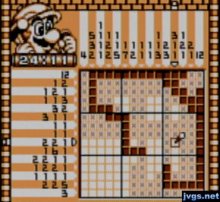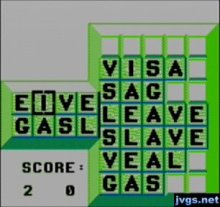Here you will find my brief reviews of Game Boy games, along with a rating from 1 to 10. A rating of 9-10 indicates a great game; 7-8 is a good game; 5-6 is a mediocre game; 3-4 is a poor game; and 1-2 is a horrible game.
Latest additions:9
 If you combine the words "picture" and "crossword," you get "picross." Each level starts out with a blank grid (usually 10x10 or 15x15), and by using numbered clues, you must figure out which squares must be chiseled in. Each row or column has numbers listed, for example "3 4." That means somewhere in that row, there are three consecutive squares chiseled in, then one or more blank squares, and then four more consecutive squares chiseled in. By using logic and the process of elimination, you can chisel in all of the appropriate squares, which will then reveal a picture. A tutorial mode is available to help you grasp the concept. Once you get rolling, you may not want to stop. The game is very fun and addicting. And with 192 puzzles, it will keep you busy for a long time. Battery backup saves your progress, and it can even save your game mid-puzzle, which is a great feature. Mario's Picross is an excellent example of what a portable game should be.
If you combine the words "picture" and "crossword," you get "picross." Each level starts out with a blank grid (usually 10x10 or 15x15), and by using numbered clues, you must figure out which squares must be chiseled in. Each row or column has numbers listed, for example "3 4." That means somewhere in that row, there are three consecutive squares chiseled in, then one or more blank squares, and then four more consecutive squares chiseled in. By using logic and the process of elimination, you can chisel in all of the appropriate squares, which will then reveal a picture. A tutorial mode is available to help you grasp the concept. Once you get rolling, you may not want to stop. The game is very fun and addicting. And with 192 puzzles, it will keep you busy for a long time. Battery backup saves your progress, and it can even save your game mid-puzzle, which is a great feature. Mario's Picross is an excellent example of what a portable game should be.
8
This "run and gun" shooter was the first portable game in Konami's Contra series. The game is controlled just like the NES games: Press "B" to shoot and "A" to jump. Even some of the music is borrowed from those games. Three of the five levels are typical side-scrolling stages, while two of them are overhead levels similar to those in Super C. Operation C has fewer weapons in it, but that's because they removed the worthless ones. Those that remain are great. The machine gun is now the default gun, which is a big help. And there's also the spread gun, a fire gun that's better than ever, and the enemy-seeking homing gun. Operation C is shorter and easier than its NES predecessors, but it's still a blast to play.
7
 This is a two-in-one word game from Jaleco. The WordZap mode is a fast-paced, competitive game designed for two players (although you can play against the computer as well). Given eight letters, you have to find seven words (3-5 letters in length) before your opponent does. If both players find a word, it is zapped and removed from both players' lists. The other mode is a slower-paced, one-player game called WordHai. That's a combination of "word" and "Shanghai." As in Shanghai (mahjong solitaire), you can only use tiles on the outer edges of a grid. As you make words, the letters you use are removed from the grid, making new letters available. To clear a level, you must use all of the given letters; so it requires a bit more thought and planning than WordZap. It has a "challenge play" mode, in which you must clear 24 levels of puzzles. After every four levels, you are treated to an animation of a world landmark blasting off into space. Unfortunately, it doesn't have a password feature to save your progress, so all 24 levels must be completed in one sitting. Overall, Word Zap isn't the next Scrabble or Boggle, but it is an enjoyable word game that's good to take on the go.
This is a two-in-one word game from Jaleco. The WordZap mode is a fast-paced, competitive game designed for two players (although you can play against the computer as well). Given eight letters, you have to find seven words (3-5 letters in length) before your opponent does. If both players find a word, it is zapped and removed from both players' lists. The other mode is a slower-paced, one-player game called WordHai. That's a combination of "word" and "Shanghai." As in Shanghai (mahjong solitaire), you can only use tiles on the outer edges of a grid. As you make words, the letters you use are removed from the grid, making new letters available. To clear a level, you must use all of the given letters; so it requires a bit more thought and planning than WordZap. It has a "challenge play" mode, in which you must clear 24 levels of puzzles. After every four levels, you are treated to an animation of a world landmark blasting off into space. Unfortunately, it doesn't have a password feature to save your progress, so all 24 levels must be completed in one sitting. Overall, Word Zap isn't the next Scrabble or Boggle, but it is an enjoyable word game that's good to take on the go.

